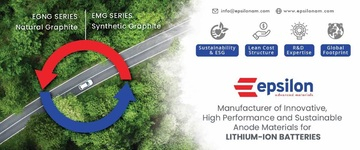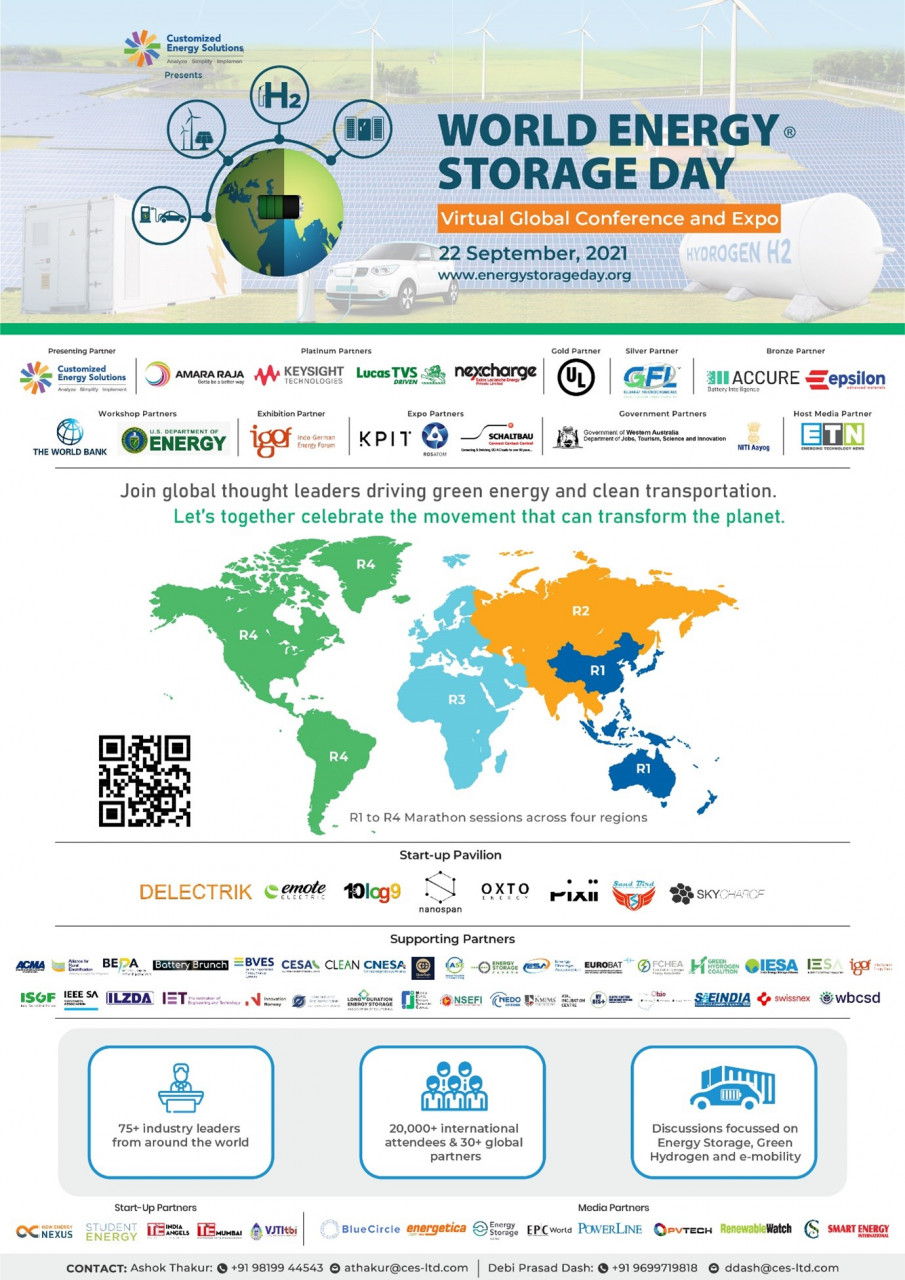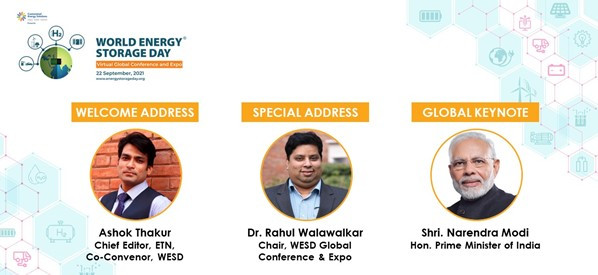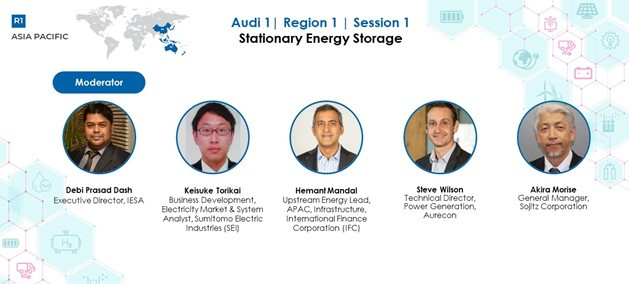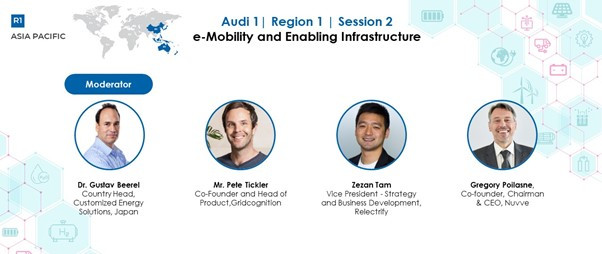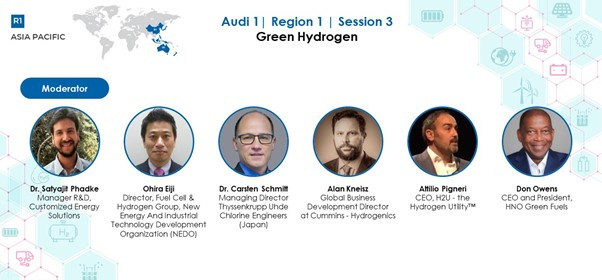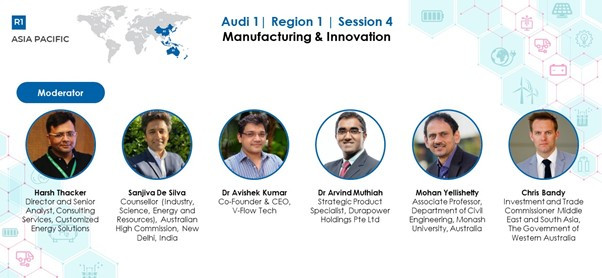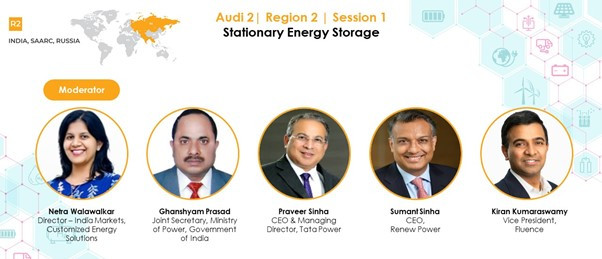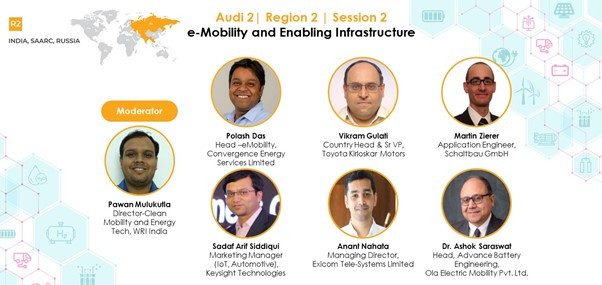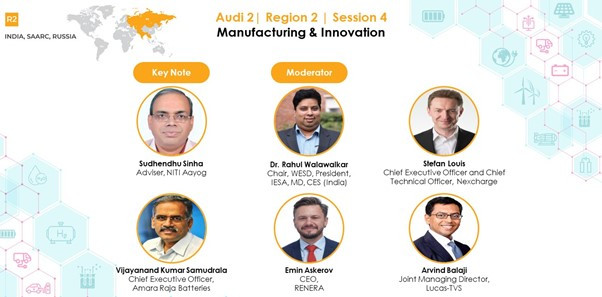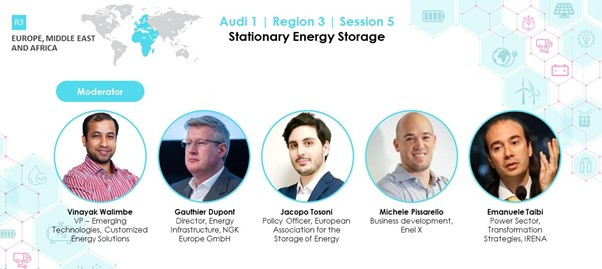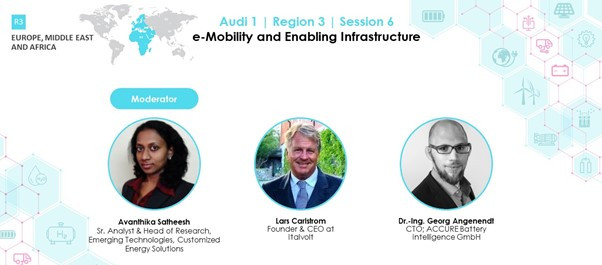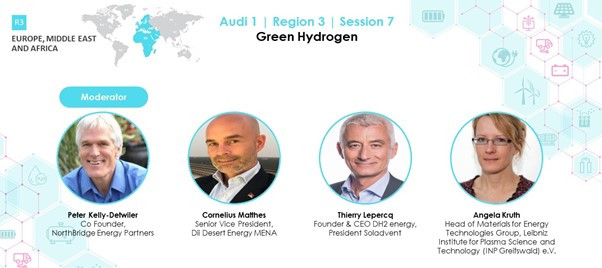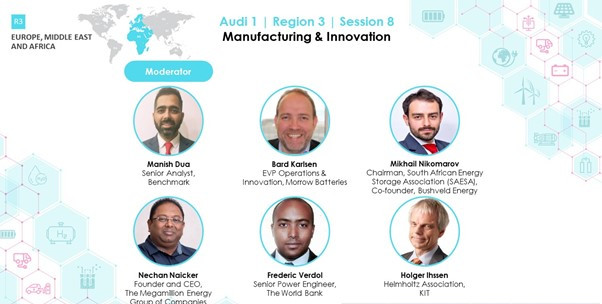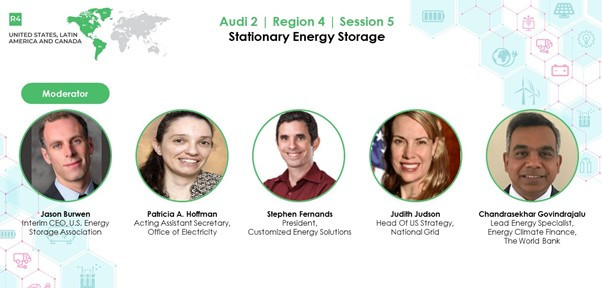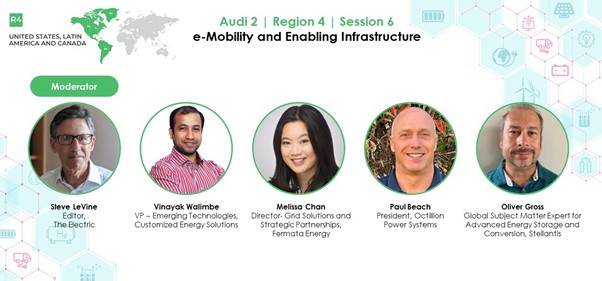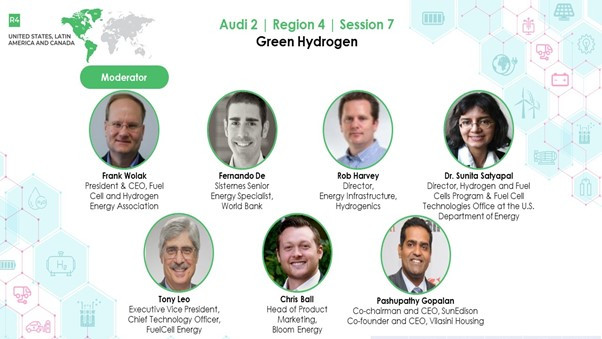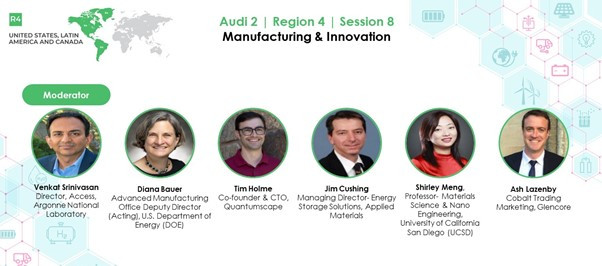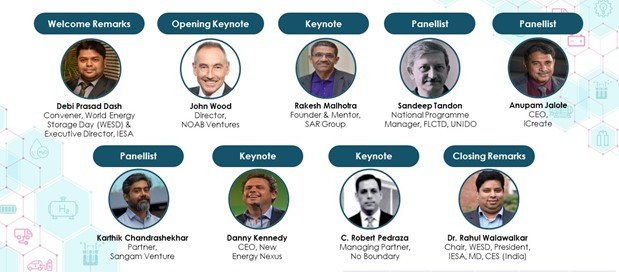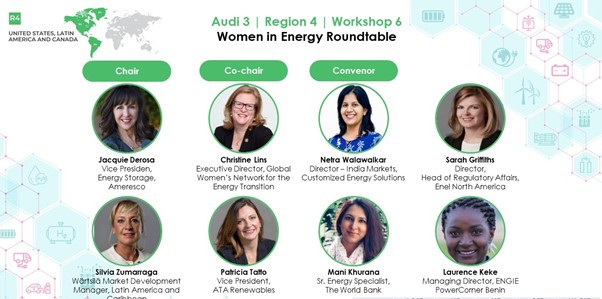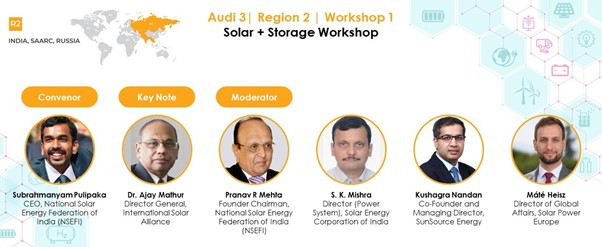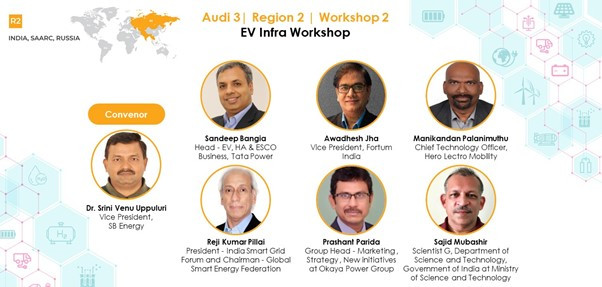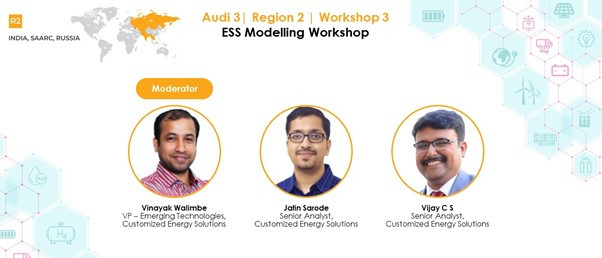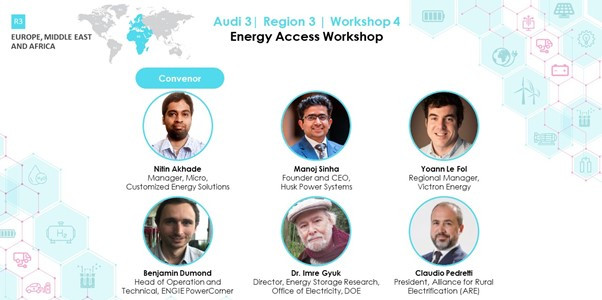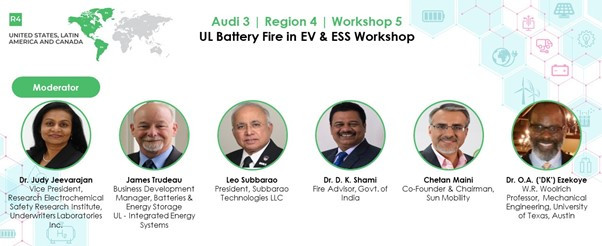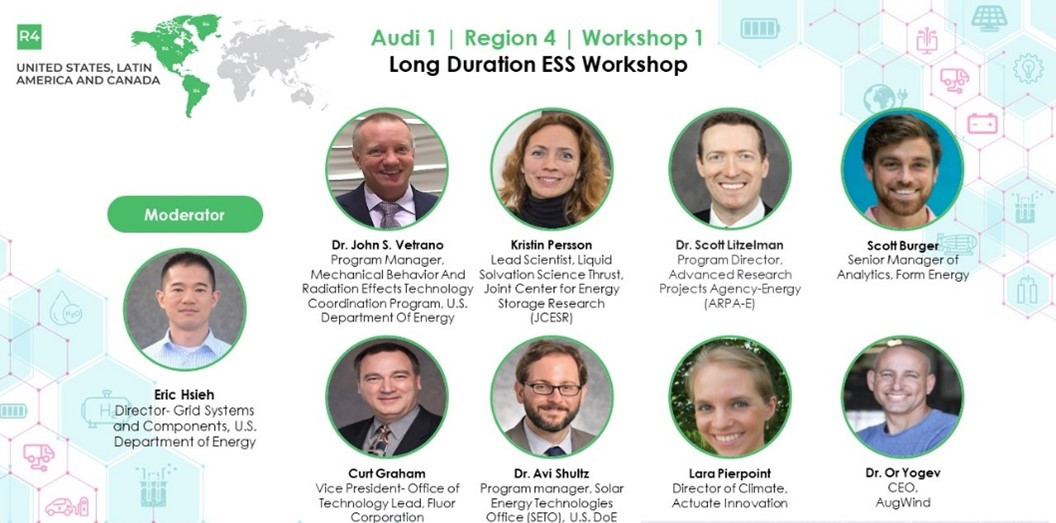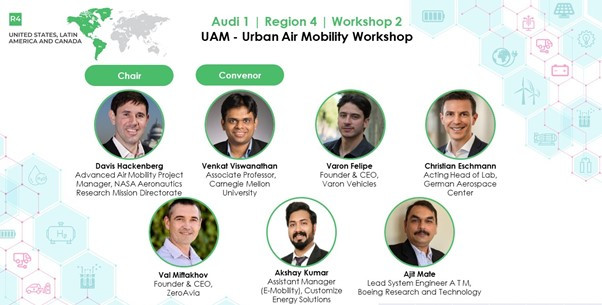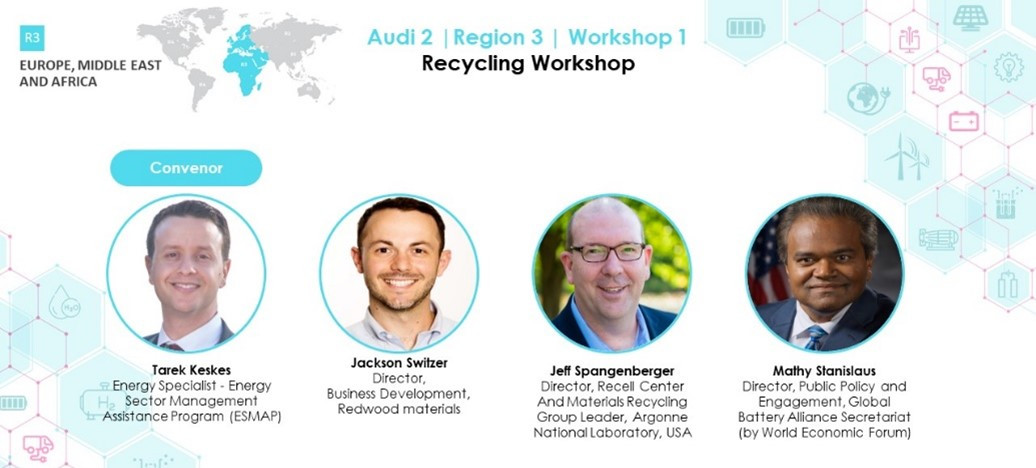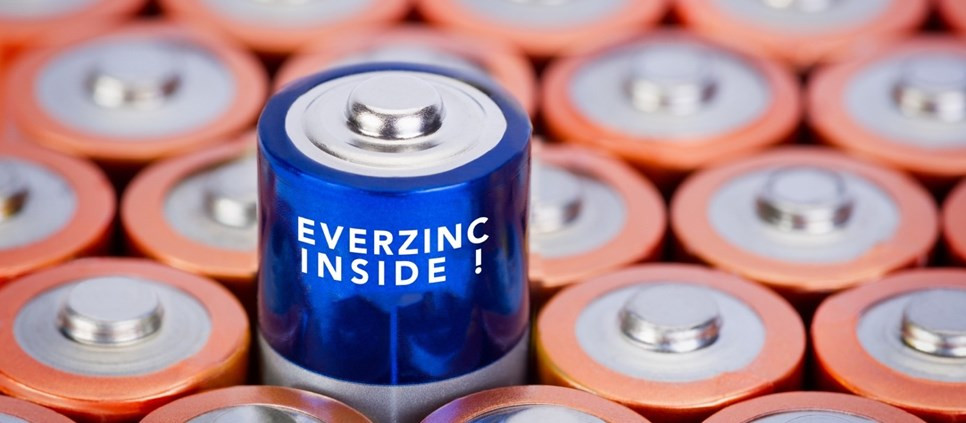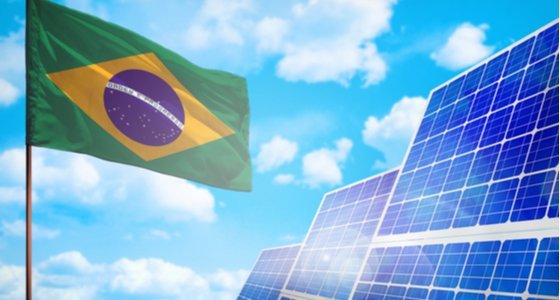World Energy Storage Day 2021 – Global Conference & Expo
Recognizing the significance of energy storage in enabling greener grid and cleaner transportation, Customized Energy Solutions (CES) and India Energy Storage Alliance (IESA) along with its supporting partners successfully concluded the 5th World Energy Storage Day - Global Conference & Expo on September 22, 2021.
The 24-hour marathon conference brought together industry veterans, policymakers, academia, innovators, and professionals from around the world on a single platform to deliberate on the role of energy storage in a world transitioning to low-carbon, green and resource-efficient economies.
Like last year, the WESD 2021 conference was a virtual event due to the COVID-19 travel restrictions. Nonetheless, the conference received a thumping response with more than 150 international speakers, recording a platform footfall of 40,000+ from 60+ countries.
This year, in addition to the 16 sessions on stationary energy storage, e-mobility, green hydrogen, and manufacturing & innovation covering four global regions (Asia Pacific; India and Russia; Europe, Middle East & Africa; and North & South America), WESD also hosted a 'Women in Energy' roundtable and a 'Clean-tech Business' forum.
With the view to deepen the participants understanding of relevant clean-tech topics, 10 expert-led workshops were conducted on a range of subjects like solar-plus-storage, EV charging infrastructure, energy storage systems, energy storage project modeling, EV battery fire and safety, long-duration storage, recycling, and circular economy, energy access, and urban air mobility.
"This decade presents the biggest opportunity and perhaps the last chance for all of us to reverse the trend driving climate change," said Dr. Rahul Walawalkar, President & MD - CES and IESA in his keynote address at WESD 2021.
"A range of energy storage technologies are poised to play a key role in decarbonizing the electric grid, mobility as well as other industrial sectors. Although there is competition among different forms of storage technologies, the real fight is against the status quo."
Below are the key ideas and insights shared by the panellists.
Dr. Rahul Walawalkar, Chair - World Energy Storage Day Global Conference & Expo
While many countries and regions are aiming for self-sufficiency and energy security, there are ample opportunities for global collaborations from supply chain to R&D to developing markets and learning from policy and business model innovation.
Ashok Thakur, Chief Editor – ETN, Co-convenor - WESD
The world has woken up to the cause of green energy… RE integrated grid, emission-free transportation, reducing reliance on fossil fuel, and in the process, realizing the undeniable role of energy storage in making it possible.
Debi Prasad Dash, Executive Director- India Energy Storage Alliance (IESA)
IESA aspires to bring a holistic approach to growth in energy storage, together with all stakeholders across the globe.
Keisuke Torika, Business Development / Marketing Specialist / Electricity Market & System Analyst - Sumitomo Electric
Vanadium flow battery systems are greatly suitable for grid use, with long cycle life, reusability, reliability, and localization.
Matt Stein, Representative - China Energy Storage Alliance (CNESA)
China's energy storage is expected to reach 35-56 GW in 2025, with new energy storage reaching 150 GW by 2030, thanks to the rapid increase in new energy penetration.
Hemant Mandal, Senior Energy Specialist: Upstream APAC - International Finance Corporation (IFC)
There is an increasing demand for scalable low-carbon energy solutions. We at IFC target financing of 17.5 GWh storage under the flagship ESMAP umbrella.
Steve Wilson, Technical Director -- Power Generation- Aurecon
Power system services continue to transition to high levels of sophistication with the expansion of renewables and the storage market.
Akira Morise, Asst. General Manager -- Sojitz Corporation
There is an emerging adoption of BESS for frequency regulation in recent times, thanks to a reduction in costs of energy storage and enhanced technological integration.
Dr. Gustav H. Beerel, Country Head-Japan -- Customized Energy Solutions
At present, EVs are in the 'introduction' and 'growth' phase. Pricing and customer satisfaction are critical in sustaining this phase, as innovators and early adopters are the key stakeholders in this development.
Pete Tickler, Co-Founder and Head of Product -- Gridcognition
E-mobility is a 'power problem', not an 'energy problem', as energy systems are increasingly becoming power systems with decarbonization efforts in all sectors.
Zezan Tam, Vice President- Strategy and Business Development - Relectrify
Relectrify's cell-level control electronics help improve battery life, reduce costs, and improve safety and resilience to individual cell failures.
Gregory Poilasne, Co-Founder, Chairman & CEO - Nuvve
The electric grid is not ready and smart charging will not be enough to address the needs of the EV industry. An ideal solution is to develop vehicle-grid integration to achieve low volatility.
Kenji Yodese, Manager, Toyota Tusho Co.
Balanced power with V2G technology is essential to expand the reach of renewable energy in the emerging market.
Ohira Eiji, Director - New Energy and Industrial Technology Development Organization (NEDO)
Hydrogen is key to achieving carbon neutrality. The technology is ready, there is a need to enhance its application and improve efficiency. Scaling up and integration with other energy systems is critical to this endeavor.
Dr. Carsten Schmitt, CEO - ThyssenKrupp Uhde Chlorine Engineers (Japan) Ltd.
Green hydrogen has turned out to be the missing piece of the energy puzzle. We are witnessing a transition from small-scale pilots to industrial-scale green hydrogen applications. Scaling up achieves traditional economic advantages, but also improves efficiency.
Alan Kneisz, Global Business Development Director – Cummins-Hydrogenics
Hydrogen is the most abundant zero-emission fuel available. With aggressive decarbonization targets, captive markets have large demands for green hydrogen. Producing green hydrogen can be cost-effective, considering some of the world's lowest renewable energy prices.
Don Owens, CEO - HNO Green Fuels
Addressing back carbon is critical to addressing the effects of climate change. Green Hydrogen is the right technology to help cut black carbon emissions and ultimately save the planet.
Sanjiva De Silva, GM at Industry, Science, Energy, and Resources - Australian High Commission New Delhi, India
Both the Australian and Indian governments are encouraging private sector investments in mining and allied industries, whose partnership stems from some commonalities and vision of addressing environmental and climate change challenges.
Dr. Avishek Kumar, Co-founder, and CEO - V-Flow Tech
Vanadium is one of the most abundant materials and is recyclable. VRF energy storage system is unique due to its low-cost innovation saving upfront investment in the system. It is easily scalable, requires 90 percent less investment than other technologies.
Chris Bandy, Investment and Trade Commissioner South Asia - Government of Western Australia
Western Australia is a leading region with all key minerals meant for manufacturing rechargeable batteries. Our key priorities are to improve participation in global supply chains, promote investment opportunities, certify battery minerals, support energy storage applications, and develop local capabilities.
Dr. Aravind Muthiah, Strategic Product Specialist - Durapower Holdings Pte Ltd
About battery safety, the choice of system-level safety measures plays a significant role, while the choice of cathode chemistry plays a limited role.
Mohan Yellishetty, Co-Founder - Critical Minerals Consortium; Associate Professor -- Department of Civil Engineering, Monash University, Australia
There is a need to broaden understanding of the criticality of minerals to assist innovation and expertise.
Ghanshyam Prasad, Joint Secretary - Ministry of Power, GoI
We are also drafting the National Electricity Policy; the 2005 policy is being re-drafted. The key focus in that policy is going to be energy transition, which will further focus on the storage system and will include BESS, hydro-pump storage, hydrogen, and all the types of storage, which is a concern for the electricity sector. Some of the sops which were given to the RE sector will be given to the storage sector as well.
Praveer Sinha, CEO & MD -The Tata Power Company Ltd
We set up the first10 MWh plant in New Delhi intending to understand the impact at the grid and utility level of frequency matching, of managing the peak powers, step-up, and step-down of peaking requirement, etc.
Rahul Jain, Head of Energy Storage - ReNew Power
Today we offer the cheapest form of renewable energy available anywhere globally. India is about to achieve its goal of 175 GW. Both these are big statements to make to the entire world. The rapid growth has been possible due to the country's favorable policies.
Kiran Kumaraswamy, VP- Growth - Fluence
In an asset like energy storage, it is very important to think of the long-term cost of ownership. A solar asset has a binary output with no decision-making involved: when the sun shines you produce energy and when it doesn't you don't.In contrast, there is constant decision-making involved in an energy storage asset. Whether you take out energy or put in energy into the grid happens on a sub-second basis, minute basis, and hourly basis.
Vikram Gulati, Country Head & Sr. VP – Toyota Kirloskar Motors
Despite huge efforts to spur e-4W adoption, projections by BNEF for India by 2025 are 1.8 to 2 percent penetration of new vehicles sales. By 2030 it will be 8 percent. Going forward the government can have a huge impact on off-take for BEVs as well as the creation of infrastructure for the adoption of EVs. The key here is to bring down the price of EVS, for which we need to see how rapidly we can scale up manufacturing of EV parts in India at a global scale and global quality. PLI will play a part, but GoI needs to connect taxation structure to vehicles based on carbon emissions.
Sadaf Siddiqui, Marketing Manager (IoT, Automotive) - Keysight Technologies
Testing is critical because we are talking batteries which will be the heart of the systems. We have instances of batteries in smartphones exploding, so we must be very sure that we have done a sufficient amount of testing with the right tools and also deployed sufficient resources. Certainly, tests and measurements play a vital role for any products using batteries.
Martin Zierer, Application Manager -- Schaltbau GmbH
The total cost of ownership of the EV is better than the combustion engines. We just have a high investment that needs to be overcome. Until that price parity is achieved, there needs to be some governmental tax relief or concessions. In Germany, the taxation on a car is strongly linked to the carbon output. So, an electric vehicle is given taxation benefits. This is an excellent tool to incentivise the purchase of EVs.
Anant Nahata, Managing Directo - Exicom
Charging is a critical element of the ecosystem especially when we are talking about EV adoption. In India, currently, 99.5 percent is home charging, and it will remain the dominant mode. It is critically important therefore that home charging should be made smooth.
Dr. Ashok Saraswat, Head, Advance Battery Engineering & Chief of Center for Cell and Battery Research - Ola Electric Mobility Pvt Ltd
To make a good business case for setting up a Giga factory, the economy of scale is a given. During the recent consultation with the industry, on the current demand in India, it was felt that right now we have to work on future projections and expectations of a pick-up in demand. In that light industry leaders feel that 5 GWh is needed to make a good business case and to be profitable.
Polash Das, Head-E-mobility -- CESL (part of EESL, Ministry of Power, Govt. of India)
The good thing is that there will be an aggregation of thousands of buses through the Grand Challenge. We will see a reduction in the prices, and it will also give some comfort to OEMs so they can reduce costs and there will be some realization in contracting and technical specifications. With this, the government is coming out with a tender of 5 000 electric buses, one of the kinds in the world for such a large procurement. We are hoping for good participation from the OEMs and STUs (State Transport Operators) in the coming three months.
Tarun Kapoor, Secretary - Ministry of Petroleum & Natural Gas, GoI
Green Hydrogen-powered vehicles would become a reality in the future as the planning and discussions are on cards. We could face various challenges in terms of assembling, plants, storage, and transportation, but these odds are short-lived as India is making tremendous progress in using renewable energy sources and will continue to do so.
Manoj Upadhyay, Founder & MD - ACME Group
After building India's first solar to green hydrogen to green ammonia plant four years ago on an experimental basis, the learnings are important to share: Alkaline electrolyzers can handle the renewable variation. The electrolyzer is good enough to scale up. The ammonia produced by solar can be transported cheaply using the state transportation mechanism. It can be reverted if needed by using a cracker and hydrogen can be produced for consumption. The same ammonia can be cracked, and it can run a large gas generator or a large turbine, providing peaking power. One can have 24-hour power, it is cheaper than a battery and can be stored for many days and months.
This shows is that hydrogen is quickly reaching the level of blue or grey hydrogen. What we now need is for the policymaker and stakeholders to come together, put it to the market and start using it.
DMR Panda, General Manager - NTPC
Although we carry the name Thermal, NTPC has not awarded a single project in the last six years which is based on fossil fuel, either coal or gas-based. We are also in the process of shutting down whatever we had awarded earlier. Whatever capacity we have added in the last 45 years in coal, we will add an equal amount of power to renewables.
Kowthamraj V.S., Expert - Clean-tech Manufacturing, NITI Aayog
India should aim to be for electrolyzers what China is for PV. India's dream to become a green hydrogen economy without manufacturing electrolyzers is very difficult. If India wants to be one of the largest green hydrogen utilizes in the world, then we probably have to make our electrolyzers.
Stefan Louis, CEO & CTO - Nexcharge
We [Nexcharge] believe that India as a country has immense potential to grow to a pioneer in energy storage and set an example for others. The Li-Ion market in India would see a significant shift and reach - 80 GWh by 2030, and in an optimistic scenario, we could witness the market reaching 160 GWh.
Emin Askerov, CEO - RENERA (Part of Roastam)
The Indian market offers a huge opportunity to do business with Indian partners, however, Renera sees itself more as a technology provider. We feel the best way to enter would be to partner with an Indian company that knows the market and the demand and we provide the necessary technology. At a later stage, we would co-invest in the manufacturing and R&D facilities in India.
Aravind Balaji, Jt. MD - Lucas-TVS
we have partnered with a startup from Boston called 24M Technologies to manufacture semi-solid Li-ion cells in India. It has a unique anti-flame quality, as the design of the cell prevents or minimizes the risk of a fire. It is available in LFP and NMC, it has a pouch and prismatic design, high energy density, good heat transfer capability, and cycle life. It is also re-cycle friendly and because of the elimination of liquid electrolyte, there is increased safety. 24M has also come up with real innovation in the manufacturing process that dramatically reduces CAPEX. For a country like India, which is just starting the electrification journey, we believe this is a good advantage.
Vijayanand Samudrala, President - New Energy & Amara Raja Batteries
There are certain unique challenges that we encounter in India. We can't merely replicate what is being done elsewhere. Our grid challenges are different, our energy supply is different, our micro-logistic needs are different. For example, we are not looking at long-haul travel. A large part of our problem is micro-logistics, typical urban commute patterns, drive schedules shaped by our road conditions, traffic jams, user needs.
Dr. Rahul Walawalkar, Chair – WESD; President – IESA; MD - CES (India)
Emerging storage technologies are a big opportunity for the energy sector that is working at moving away from conventional sources to renewable energy. In that, I believe there is a need to accelerate the adoption of long-duration energy storage, which includes viable technologies like hydrogen.
Gauthier Dupont, Director - Energy Infrastructure, NGK Europe GmbH
When we talk about Li-ion batteries' price, the market is using the same cell. We are using Li-ion batteries for e-mobility and their use varies for energy storage. One way for the market to reduce the cost of EVs is to reduce the performance of cells. We need companies developing Li-ion batteries which are specifically for EV and not coupled for energy storage. The different applications will require different batteries. It is important to know the difference.
Jacopo Tosoni, Policy Officer -- EASE
The regulation has a considerable effect on the energy storage sector. We witnessed significant growth despite the COVID-19 pandemic that took the world by storm. Customers for industrial and commercial applications have been conservative in 2021 as they focus on recovery. Yet, new businesses have made a case for energy storage across the sector. New business models focused on post-COVID recovery have been emerging.
Michele Pissarello, Head – Business Development New Market, Energy Storage Solutions, Enel X
Reshuffle of the network structure must change and for this very reason, there is a need to gradually roll out a regulatory framework for energy storage. Recently, the EU policy on RE states the need for flexibility and importance for developing energy storage to achieve the same.
Emanuele Taibi, Power Sector Transformation Strategies - IRENA
Each county has different reasons to look at energy storage for its varied requirements. The need for electricity will grow significantly, so the need for storage will also see a significant surge by 2050. The role of energy storage as a last-mile resource can be cost-effective as well. Hydrogen can play a significant role in enhancing energy storage and accelerating global energy transition.
Lars Carlstrom, Founder and CEO - Italvolt
We are building a 45 GW Gigafactory outside Europe and will be able to support 18.6 million electric vehicles. The lack of availability of minerals for Gigafactory in Europe will be an opportunity as well as a challenge to address. To bring back the supply chain close to the factory will be one of our agendas going forward.
Dr. Georg Angenendt, CTO - ACCURE Battery Intelligence GmbH
There are a few challenges which consist of battery failure, battery fire. So, we must prevent such incidents to make a battery the future of mobility. Making batteries safe and reliable, data is the way ahead.
Alfon Westgeest, General Manager - EUROBAT
The development in Europe has been significant with the EU green deal. Going electric is one of the key focus areas and drivers for the green deal. There is indeed a large increase in the production and demand for electric vehicles in Europe. It will only accelerate further on.
Peter Kelly-Detwiler, Consultant - NorthBridge Energy Partners
In order to decarbonize, we have to decarbonize the entire global energy economy. It is clear that green hydrogen will be a key energy carrier that will allow us to make this transition.
Dr. Angela Kruth, Head of Material- Energy Technologies Group, Leiterin Materialien für die Energietechnik, Sprecherin und Koordinatorin CAMPFIRE
We [CAMPFIRE] focus on the production of ammonia, seasonal and regional and we see significant cost advantage of this especially for the marine transport industry in addition to lowering carbon emissions. We focus on research and projects to enable an entire ammonia energy system.
Cornelius Matthes, CEO - Dii Dessert Energy
The oil and gas market has declined over the past years, and therefore it is inevitable to start massively diversifying in this decade. Even the region (MENA) understands this. There is a massive development in the region with no shortage of bold initiatives by developers, however, to work in an international context and to create joint markets (globally) for green molecules is what is needed at the moment.
Emanuele Taibi, Power Sector Transformation Strategies - IRENA
Hydrogen can be used practically across the entire energy system, but applications need to be prioritized complementing other decarbonization pathways.
Kowtham Raj VS, Future Energy Leader (FEL) Fellow - World Energy Council
India currently has $160 billion of energy imports (mainly oil and gas). As India's energy demand doubles within the next decade, the transition to green hydrogen will play a key role in reducing India's energy import bills, and also, in lowering carbon emissions.
Thierry Lieperq, Founder & CEO - DH2 energy; President - Soladvent
The way to go for India and other countries is to go to scale immediately, by bringing up to speed the midstream, downstream, and financers together. The government is helpful not only for subsidies on the downstream side but also for developing regulations, however, the leadership role has to be taken by the industry.
Bård Karlsen, EVP Operations & Innovation - Morrow Batteries
How can we substitute the most expensive raw materials with less expensive ones, and significantly reduce cost while maintaining performance? This will be very critical for the cost competitiveness of the battery.
Mikhail Nikomarov; Chairman - SAESA South African Energy Storage Association; Co-founder - Bushveld Energy
For developing economies such as South Africa, the manufacturing bit is extremely important as it is one of the pathways to achieve economic development and also create jobs for the economy. One way developing countries can look at local manufacturing is to ask, is there something that makes the country unique? That creates natural competitiveness. Something that can only be manufactured there rather than in other countries.
Frederic Verdol, Senior Power Engineer - World Bank
For the market to be created, we need visibility, planning. It is very good that South Africa was the first country in Africa to have targets on battery storage [2000MW on the grid by 2030], but it is not enough, we need more visibility on what is being done to get there, current development looks promising.
Nechan Naicker, Founder & CEO - The Megamillion Energy Group
Localizing the lithium-ion battery value chain offers an unprecedented opportunity for sub-Saharan Africa to establish itself as the global EV manufacturing powerhouse. It offers a big opportunity to start mega industries – from mining minerals, beneficiation to making battery-grade powder, and more.
Holger Ihssen, PhD - Helmholtz Association of German Research Centers
Mission Innovation (MI) is a global initiative of 22 countries and the European Commission. MI 2.0 launched in June 2021 is catalyzing a decade of action and investment in research, development, and demonstration to make clean energy affordable, attractive, and accessible for all.
Jason Burwen, CEO - U.S. Energy Storage Association (ESA)
We have different technologies and elements in the value chain of energy storage. It gives me great pleasure to say that the USA is leading the path on energy storage. Last year, was the first year, we surpassed 1GW of deployed energy storage capacity. We are now making regular procurement of multiple GW of energy storage in the USA. It is critical as it reflects that energy storage has developed as a key source for long-duration power backup across the country.
Judith Judson, VP -- Head of US Strategy - National Grid
We have made significant investments in solar and offshore wind, which necessitates great value for energy storage. In our forecast, there will be significant growth in clean energy electricity which will require strong energy storage capacity. Investment in storage will help in building a resilient grid.
Patricia Hoffman, Acting Assistant Secretary - U.S. Department of Energy (DOE)
We recognized the need for resilience technology for advanced energy storage in the USA. Longer energy storage technologies are needed as we advance. It is also critical to accomplish decarbonization.
Chandrasekhar Govindarajalu, Lead Energy Specialist - Energy Climate Finance, The World Bank
Stationary energy storage holds the key to global energy transition and addresses climate change. We have a financing program that has committed billion dollars for battery storage program, and we are less than halfway there. We estimate as of today, less than 20 percent is in the emerging market. As with developing countries, the growth will be around 50 percent, which is much significant.
Robert Galyen, SAE International Fellow and Battery Standards Steering Committee Chairman and Chairman Emeritus & CTO, NAATBatt International
Electrification is one of the biggest megatrends worldwide and transforming industries all over the world. There are several predictions that by 2040-50 there will be some major improvements and growth, but along with that requires the development of components that support the electrified vehicle.
Vinayak Walimbe, VP – Emerging Technologies, CES
What we need to ask is are we developing the infrastructure for the growth we expect for EVs? Which will support the growth of EV? We need to look at this gap and what is really needed to support EV growth.
Melissa Chan, Director-Grid Solutions and Strategic Partnerships - Fermata Energy
Electric vehicles are the most valuable untapped resource today. When we start thinking that EV batteries can be leveraged, it totally changes the question of integration.
Paul Beach, President - Octillion Power Systems
In order to bring more renewables to the grid and move away from traditional technology (coal and gas) and then move toward EVs, we see that there are different players who are working with their self-interest so this is like a symphony but there is no conductor who is organizing all these different players in a concrete way, helping the industry move in a certain direction. So, it is people like us who have to come together and conduct the symphony.
Oliver Gross, SME Energy Storage - Stellantis
We [Stellantis] recognize a few significant facts, there is a strong move towards eco-consciousness among consumers but consumers are also looking at something that meets their everyday needs— like [EV]range being one of them. Cost being another. The goal for us is to exceed this expectation.
Fernando De Sisternes, Sr. Energy Specialist - The World Bank
The recent push to large-scale energy storage will play an important role in decarbonization. Over the last 20 years, good work has been done on decarbonization. Green hydrogen can play an important role in the clean flexible energy vector. In developing countries, the challenge is that the availability of power is limited. Green hydrogen can open good prospects for long-duration energy storage.
Rob Harvey, Director - Energy Infrastructure, Hydorgenics/Cummins
There is a lot of interest around the world for green hydrogen storage applications, as many developers are looking to get into this space.
Dr. Sunita Satyapal, Director - Hydrogen and Fuel Cells Program & Fuel Cless Technologies Office, US DOE
Last year, for the very first-time renewables, crossed 1 GW. DOE has some goals in place which include a net-zero economy by 2050, long-duration energy storage development, and much more on the decarbonization path. Our H2@scale program aims to decarbonize sectors including the chemicals, transportation industry. We have new tools developed for long-duration energy storage and value proposition, hybrid system, thermal integration, and grid services using hydrogen. DOE has partnered with various organizations globally to accomplish and accelerate decarbonization.
Tony Leo, Executive VP & CTO - FuelCell Energy
We have been in the business for the past 50 years developing products on affordable fuel cell solutions. We have three different methods to generate hydrogen i.e., trigeneration, carbonate REP, and solid oxide electrolysis. Hydrogen-based energy storage can be a significant impact on energy savings.
Venkat Srinivasan, Director – ACCESS, Argonne National Laboratory
There is an opportunity for us to transform the economy and storage is going to be the key to that. But we still have some problems to solve. For transportation, we must decrease the cost, enable fast charging, and make batteries safer. In addition to the cost, we must make batteries with a lifecycle of 20-30 years, and this is a big challenge. Parallel to this, there is a big concern for the supply chain. The countries must start thinking of ways to optimize their supply chains to meet the growing demands.
Diana Bauer, Advanced Manufacturing Office Deputy Director - US DOE
Energy storage is increasingly important to contribute to the U.S and global energy system that is resilient, flexible, affordable, and secure. We aim to decarbonize electricity, transportation, energy-intensive industries, agriculture, and storage is important to this goal.
Tim Holme, Co-founder & TCO - Quantumscape
We have spent a long time developing new forms of battery. LFP (Lithium iron phosphate battery) was popular several decades ago, and it is popular even today and used in Chinese electric vehicles due to its low cost. At Quamtumscape, we are developing Li-Metal LFP and Li-Metal NMC, which can be appropriate for different technologies.
Jim Cushing, Managing Director – Energy Storage Solutions, Applied Materials:
We must make several improvements in energy storage. The challenge is to how do we make these improvements in the different areas of energy storage. We have technologies that can improve battery performance and help drive adoption for critical applications. The challenge is not to have essential material but to be able to manufacture these batteries, their scale, and cost.
Shirley Meng, Professor – Materials Science & Nano Engineering, University of California San Diego
We have seen interesting and intriguing evolution history of battery over the years. This decade belongs to energy storage.
Ash Lazenby, Cobalt Trading Marketing - Glencore
The whole industry is inclined towards the development of raw materials that will be integral to advancing energy storage technologies. One of the challenges of raw material supply is a longer lead time and this needs to be addressed. We believe there is a lot of cobalt, and it will require an aligned supply chain for sourcing it consistently on the reasonable expectation of what is required. Cobalt demand is going up.
GLOBAL STARTUP SHOWCASE PROGRAM
To encourage innovation in the cleantech and storage space, WESD – 2021 held a Global Start-up Showcase Program which witnessed the participation of clean-tech startups from various regions across the globe. At the program, entrepreneurs got an opportunity to pitch their startup ideas to big-ticket investors. More than 80 startups registered for the program, of which 17 were shortlisted for the final pitch presentation by a set of independent evaluators.
The program also witnessed the participation of 20+ global investors in the pitch session, NOAB Ventures, Gold Ventures, Climate Seeds Fund, Indian Angel Network, Theia Ventures, Altius Ventures, IFC, cKers Finance were a few of the prominent investors who attended the Global Start-up Showcase Program.
Based on the evaluators' scores, the top 5 startups selected from the program are:
1.Log 9 Materials Scientific Private Limited (1st)
2.NavAlt Solar and Electric boats Pvt. Ltd. (2nd)
3. OXTO Energy (3rd)
4. Chargetrip (4th)
5. Emote Electric Private Ltd. (5th)
WORKSHOPS
Women in Energy
The Women in Energy roundtable was chaired by Jacqueline DeRosa, co-chaired by Christine Lins, and convened by Netra Walawalkar. In the roundtable, women leaders from the energy sector across the globe discussed the advancement and opportunities for women in the clean energy transition and emphasized the significance of women networking. The co-chair, Christine Lins presented the study conducted by GWNET about Women for Sustainable Energy - Strategies to Foster Women's Talent for Transformational Change.
In the latter half, the panel shared their professional journey and experiences and challenges they faced as women leaders along the journey. The panel also highlighted the importance of having gender diversity in the sustainable energy sector. Lastly, the speakers discussed key qualities to climb the leadership ladder and the means to increase women's participation.
Solar + energy storage
With the rise of renewable energy, the demand for storage solutions is growing rapidly. The future of the energy infrastructure lies in smart storage solutions for diverse market applications including solar shifting, smoothing, and ramp control, and grid stability seamlessly combining premium hardware, advanced software, and reliable services. With the fast development of mechanical and electrochemical energy storage technologies, storage can strongly support the transition to solar energy. Energy storage is the missing piece of the energy transition puzzle. As the energy industry warms up to these technologies, utilities, developers, consumers, and power producers across the globe adopt and install energy storage systems from kW-level to GW level.
In this workshop, global thought leaders and industry stalwarts deliberated about technology, applications, and market for solar + energy storage integration. The workshop covered case studies from rooftop solar to grid-scale projects and pumped hydro technologies to advanced li-ion and emerging electrochemical batteries.
EV Infrastructure
In the past decade, global automakers and component manufacturers have shifted their focus to electric mobility and EV charging infrastructure. Charging infrastructure is the backbone of EV adoption. The availability of a user-friendly public charging infrastructure is one of the key requirements to drive the electric vehicles market in India. In this regard, the government of India has taken several initiatives to expedite the development of public charging infrastructure across the country. The policies and initiatives such as National Electric Mobility Mission Plan, FAME-I and II, National Mission for Transformative Mobility and Battery Manufacturing, Phased Manufacturing Program, Advanced Chemistry Cell Production Linked Incentive Scheme have been devised to give the required boost to the sector.
WESD Electric Vehicle Infrastructure workshop brought together global experts and practitioners in this exciting area to share their experience and vision for a sustainable future.
Energy Storage Modelling
As more and more renewables are getting integrated grid operations are becoming complex. Energy storage is a versatile technology that can bring needed flexibility. Storage can serve as peaking capacity, can provide ancillary services as well as operate as a transmission and distribution asset. However, energy storage is an energy-limited resource that creates a need for careful modeling to optimize the operation and maximize the value of the asset. Powered by CES' proprietary modeling platform CoMETS, this workshop discussed practitioners' approaches to modeling and shared examples of energy storage modeling for planning, investment decisions, as well as operations.
Energy Access: Energy Storage Linked Challenges in Clean Energy Mini grids
Clean energy mini-grids are paving the way for development in remote areas and helping achieve the critical goal of Universal Electricity Access across the world. Due to their compact nature and innovative service models, mini-grids are the preferred model of rural electrification in most parts of the world. But the very reason that they are suitable for remote and far-flung areas for electrification also puts additional thrust on technology, in terms of the challenges mini-grid technology must address while providing 24x7 clean electricity to local communities. Every mini-grid geography brings up its unique challenges. This workshop provided a unique opportunity for the mini-grid developers to share the key challenges they face on the energy storage front – both at the time of commissioning and during its operation in their mini-grids.
Battery Fire in Electric Vehicles & Energy Storage System
This workshop addressed a few different aspects related to battery fire safety in electric vehicles (EVs) and stationary grid energy storage systems (ESS). In the past decade, the growth in the EV and ESS sectors has been exponential. The availability of various battery chemistries and the awareness in reducing the carbon footprint and increasing environmental cleanliness has led to large investments in these two sectors. However, due to the nature of the battery chemistries being used, challenges concerning safety still exist.
Speakers at this workshop discussed the growth of the EV and ESS sectors and the safety challenges faced by these sectors globally as well as in regional contexts. References to existing standards and research carried out in the area of characterizing fire and thermal runaway experimentally and with modeling methods will be presented.
Long-duration Storage
From materials to markets, innovations at all stages will be required to deploy the next generation of long-duration energy storage systems. The Department of Energy (DOE) representatives along with industry leaders held mini panels on foundational innovations, technologies beyond lithium-ion, and the process from scaling to commercialization. This workshop served as a guide to the next generation of energy storage. This workshop included discussions on the understanding of battery fire safety, especially in the EV and ESS sectors, safety hazards and challenges of lithium-ion batteries, modeling, and simulation of lithium-ion battery fires, and battery fire characterization.
Urban Air Mobility
This workshop deliberated on Urban Air Mobility and the scope of on-demand aviation to radically improve transportation, giving people back the productivity lost in their commutes. Just as skyscrapers allowed cities to use limited land more efficiently, urban air transportation uses three-dimensional airspace to combat transportation congestion. The workshop deliberated on the radical technological developments in batteries and fuel cells that have made advanced and sustainable aviation a near-term possibility.
Advancing the Nexus of Energy Access and Circularity
This workshop covered battery recycling, recycling technologies, and global practices. It also presented the conclusions of the report "Closing the Loop on Energy Access in Africa" to address energy access and end of life management in Africa based on analysis and consultation with stakeholders and globally. The report was a product of collaboration between the Global Battery Alliance (GBA) - World Economic Forum and the Faraday Institution within the framework of the World Bank's Energy Storage Partnership and with the support of Vivid Economics and Öko Institut, Berlin.
ESS Projects
This workshop shed light on recently executed hybrid energy storage feasibility studies in countries new to storage as a grid-scale supply platform, by a team of Customized Energy Solutions, Delphos International, and POWER Engineers. The panelist discussed common approaches to execution and challenges that appear to be consistent across these types of opportunities. This workshop deliberated on the core application of storage in these instances to plant optimization, site design, and project financing. The team also discussed ways of identifying pathways to enable the mass deployment of energy storage and regulatory structures, market design, and investment pathways that were proven as best practices around the world while also being tenable for emerging markets.

